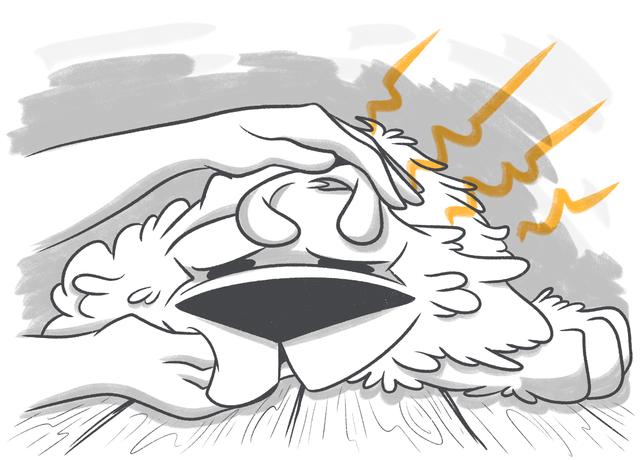Swollen lymph nodes in dogs could mean a simple infection that requires antibiotics. or a case of lymphoma cancer that requires chemotherapy. With vague symptoms and rapid progression, lymphoma shows the importance of knowing what’s normal and what’s not with your pet.
Content:
- What Are Lymph Nodes in Dogs
- Symptoms of Swollen Lymph Nodes in Dogs
- Dog Lymphoma Stages
- Treatment for Swollen Lymph Nodes
- How Can the Emergency Fund Help with Treatment
- FAQ
- Conclusion
What Are Lymph Nodes in Dogs
Lymph nodes and the lymphatic system make up part of the immune system in dogs and are responsible for jobs such as:
- Fighting disease by producing antibodies;
- Removing tissue and cell waste;
- Moving proteins and white blood cells around the body;
- Absorbing gastrointestinal tract fats.
Stop Googling - Ask a Real Vet
There are several lymph nodes, some of which are deep inside your pet’s body. Five sets are in areas you can physically feel, and these are:
- The upper rear of the leg: popliteal✡
- Armpit: Axillary
- Lower jaw-neck: submandibular✡
- Shoulder-neck: Prescapular
- Groin: Inguinal
The ones marked with an "✡" are the easiest to feel with your hands, but only when they are pronounced. It’s difficult to feel swollen nodes in dogs that are obese and in nodes that aren’t swollen or are only mildly swollen.
Symptoms of Swollen Lymph Nodes in Dogs
Normally, you won’t be able to feel the lymph nodes in your dog. It is only when they are swollen that you can feel them by running your hands over the area. You can sometimes see them with severe swelling.
Get used to how your pooch feels on a normal day when they aren’t ill. How does their skin feel? Are there any lumps and bumps? When you know what is normal, you’ll be able to quickly pick up on what isn’t.
The symptoms your pet will experience alongside swollen lymph nodes will heavily depend on the cause. The causes can include:
Infections
Bacterial and fungal infections can cause your pet to have enlarged lymph nodes. This is a good sign because it means the nodes are providing plenty of disease-fighting cells. The location of the infection will determine the lymph nodes that will swell up.
Dental disease, infections of one or both ears and chest, or respiratory infections affect the lymph nodes around the head and neck: submandibular and scapular. They will also cause symptoms such as:
- Shivering/shaking;
- Fever;
- Increased sleeping;
- Decreased interest in exercise or toys;
- Reduced food and water consumption;
- Swollen abdomen;
- Coughing;
- Wheezing;
- Localized pain;
- Nausea, heaving, and vomiting;
- Snappy behavior.
Some infections can cause the lymph nodes to swell up all over the body rather than just in one or two localized spots. Demodectic mange, canine plague, Lyme disease, and other tick-borne diseases, several fungal infections, and reactive hyperplasia can all cause this kind of full-body reaction.
Tick-Borne Diseases
There is a lengthy list of diseases that can transfer to and afflict dogs from tick bites. Lyme disease comes with all the symptoms mentioned above, along with limping or lameness in the limb closest to the bite location. The swelling can spread to one or more other limbs.
Ehrlichia is a disease caused by bacteria passed on through tick bites. It has all the same symptoms as previously mentioned, plus:
- Increased bruising;
- Bleeding easily;
- Bleeding that doesn’t stop;
- Rapid weight loss.
Brown or red-colored urine could be indicative of tick-borne Babesia, and neurological issues are linked to Rocky Mountain spotted fever.
Cancer
Lymphoma in dogs is the equivalent of non-Hodgkin’s lymphoma in people, and there are more than thirty different types. Four are more common than the rest, and the most common is multicentric lymphoma, which accounts for up to 85% of all canine lymphoma cases, according to the American Kennel Club study.
Enlarged lymph nodes are often the easiest symptom to spot, as they can swell to up to ten times their regular size. The other symptoms are listed above. Your dog could just as easily have cancer as they could have an easily treatable ear infection, which is why it’s so important to have the symptoms looked at by a vet as soon as possible. You can use the footage from your Petcube Camera to give them a full and complete picture of your pet’s behavior and issues.
The symptoms of the final stages of canine lymphoma are often respiratory-based. The nodes can swell up so much that they block airways and restrict breathing. Mobility, appetite, and energy are seriously depleted, leading to weight loss and a sick appearance.
Read more: Dog Skin Cancer
Dog Lymphoma Stages

Lymphoma cancer is classified as systemic, which means that it affects multiple parts of the body. The opposite, where the cancer is in one location only, is known as localized cancer. Systemic disease works its way through stages, of which there are five.
During the first stage of dog lymphoma, a single lymph node is affected. Symptoms are minimal or nonexistent at this point, which is classified as Substage A (no symptoms). This is the best time to start treatment for an excellent prognosis and remission.
Second-stage lymphoma means a spread to a second, close node, or multiple close nodes. This is when obvious symptoms can start to materialize, known as "substage B" symptoms, and impact life. Most lymphomas are aggressive, which means they act fast and spread faster. Without treatment, most dogs aren’t expected to live for longer than two or three months once obvious symptoms appear.
At stage three, there are no remaining healthy lymph nodes. The lymphoma cancer has spread to all of them. Stages three and four are the most common at the time of diagnosis.
The disease spreads further to reach stage four. The chest and its organs, spleen, and liver are also affected, along with all nodes.
Stage five is the final stage. At this point, the cancer has spread not just to other organs but also to the bone marrow.
Read more: Brain Tumor in Dogs
Treatment for Swollen Lymph Nodes

Your vet will need to determine the cause of your dog’s swollen lymph nodes before treatment is administered. Alongside a physical examination, blood tests, biopsies, and tissue analysis are used to get to the underlying medication condition.
Cancer will require surgery or ongoing treatments, such as chemotherapy. Fungal infections, on the other hand, will need anti-fungal medication. Antibiotics, painkillers, steroids, and anti-inflammatory drugs can also be prescribed, depending on the cause.
How Can the Emergency Fund Help with Treatment
With breathing issues, appetite problems, and weight loss, lymphoma in dogs doesn’t take long to become obvious and urgent. With vague symptoms, it’s not easy to know whether to make an appointment, but that’s where Petcube’s Emergency Fund can help.
As well as being there for life-threatening pet emergencies, the Emergency Fund comes with expert advice from professional, friendly, and qualified vets, and they’re available around the clock. For less than $1 per day, not only will you have cover for costly urgent medical care up to the value of $3,000, but you’ll also have a dedicated team right at your fingertips.
FAQ
Which Dog Breeds Are Prone to Swollen Lymph Nodes?
Swollen lymph nodes can affect any dog at any stage in their life. It is not a symptom that specific breeds are more or less prone to. Cancer can happen at any time, in any place, and for any reason, and dogs can pick up infections and other bugs in all sorts of places.
You can even take them into your pet’s home on your clothes, footwear, or body. Certain breeds are more prone to lymphosarcoma (cancer), such as Rottweilers, Boxers, Golden Retrievers, and Dobermans.
What is the Dog Lymphoma Prognosis?
Treatment during substage A is more likely to have an excellent prognosis, with full remission and a long, healthy life afterward. Around 10% of pets are completely cleared following combination chemotherapy. Sadly, diagnosis and treatment beyond this point lead to life expectancies of around six to twelve months.
Conclusion
You can check your dog’s lymph nodes yourself if you’re aware of how their body feels in a non-swollen and fully healthy state. Get to know your pet and what’s normal for them. It’s the best way to keep on top of any weird symptoms, and it’ll allow you to get your precious pet treated as quickly as possible.
Was this article helpful?
Help us make our articles even better









